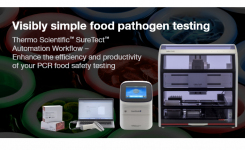The new, end-to-end qPCR workflow from Thermo Fisher Scientific is designed to minimize the potential for contamination of the food supply and risk to handlers and consumers.
Data from the World Health Organization (WHO) indicates that transmission of coronavirus is not likely to occur from handling or consuming food. Practically, the risk will be much lower from surfaces than from a direct respiratory droplet travelling through the air from an infected person. However, research shows that coronaviruses can survive on different surfaces for up to nine days under specific conditions such as temperature and humidity1. The risk, therefore, remains that SARS-CoV-2 transmission can occur when a healthy person touches contaminated food or food contact surfaces (including packaging materials) and then touches their mouth, nose, or eyes.
As with any potential outbreak situation, proper cleaning, surveillance, and the prevention of cross-contamination are critical in the control of foodborne illnesses. Industries such as food producers, retailers, and public health authorities have the primary responsibility to ensure that their food is safe, not just in relation to SARS-CoV-2, but any preventable food-related illness.
Thermo Fisher is presenting a new workflow designed to detect SARS-CoV-2 from food packaging and environmental monitoring. The implementation is geared towards decreasing the potential for contamination of the food supply and subsequent infection of handlers and consumers.
- Ease of sample collection is the first crucial step in this workflow, and to ensure efficient surface sampling, Thermo Fisher recommends its nylon or polyester swabs.
- For transportation to the testing laboratory, Thermo Scientific Viral Transport Medium or Phosphate Buffered Saline provide buffering and the stability needed to maintain the virus and helps to ensure accurate results are achieved.
- For nucleic acid extraction, options are available to suit the laboratory application, from medium-high to low-medium-throughput automated preparation (Thermo KingFisher Flex Purification System), as well as manual preparation with the Invitrogen DynaMag-2 Magnet.
The Applied Biosystems PrepSEQ Nucleic Acid Extraction Kit for Food and Environmental Testing provides a universal set of nucleic acid extraction reagents that can be used across both automated and manual extraction methods.
Both the Applied Biosystems QuantStudio 5 and 7500 Food Safety Fast Real-Time PCR Systems are recommended for use not only for the detection of SARS-CoV-2 when testing samples from food packaging and environmental monitoring, but also for running tests for a range of other targets important to food safety and environmental testing. For example, foodborne pathogens can be detected with validated accuracy and precision using the Thermo Scientific SureTect Food Pathogen Detection System.
Thermo Fisher is at the heart of the global response to the COVID-19 pandemic. Over 50 percent of COVID-19 testing is performed on Thermo Fisher technology, making it uniquely placed to provide a complete solution for detecting the virus from food packaging and environmental monitoring.
Find out more about detection of SARS-CoV-2 for food packaging and environmental monitoring at thermofisher.com/food-sars-cov-2.
References
1 FAO. 2020. Food Safety in the time of COVID-19. Rome
























